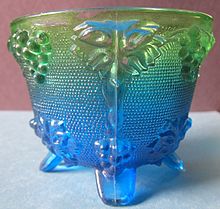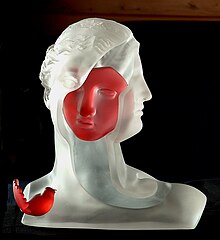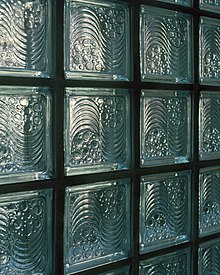64:
20:
135:
238:
202:" method. Using this method, a model can be made from wax and after investment the wax can be steamed or burned away in a kiln, forming a cavity. The mould is equipped with a funnel-like reservoir filled with solid glass granules or lumps. The heat resistant mould is then placed in a kiln and heated to between 800 °C (1,470 °F) and 1,000 °C (1,830 °F) to melt the glass. As the glass melts it runs into and fills the mould.
155:. Bentonite acts as a binding material. In the process, a small amount of water is added to the sand-bentonite mixture, and this is well mixed and sifted before addition to an open topped container. A template is prepared (typically made of wood, or a found object or even a body part such as a hand or fist) which is tightly pressed into the sand to make a clean impression. This impression then forms the mould.
172:
180:
125:
industries, and in the case of carinated bowls and dishes, from the ceramic industry. Cast vessel forms became more limited during the late 1st century, but continued in production into the second or third decade of the 2nd century. Colourless cast bowls were widespread throughout the Roman world in
158:
The surface of the mould can be covered in coloured glass powders or frits to give a surface colour to the sand cast glass object. When the mould preparation is complete hot glass is ladled from the furnace at temperatures of about 1,200 °C (2,190 °F) to allow it to freely pour. The hot
271:
is also used in the hot forming of glass. Graphite moulds are prepared by carving into them, machining them into curved forms, or stacking them into shapes. Molten glass is poured into a mould where it is cooled until hard enough to be removed and placed into an annealing kiln to cool slowly.
256:. The resultant paste is applied to the inner surface of a negative mould forming a coating. When the coated mould is fired at the appropriate temperature the glass is fused creating a hollow object that can have thick or thin walls depending on the thickness of the pate de verre layers.
159:
glass is poured directly into the mould. During the pouring process, glass or compatible objects may be placed to later give the appearance of floating in the solid glass object. This very immediate and dynamic method was pioneered and perfected in the 1980s by the
150:
involves the use of hot molten glass poured directly into a preformed mould. It is a process similar to casting metal into a mould. The sand mould is typically prepared by using a mixture of clean sand and a small proportion of the water-absorbing clay
191:
materials such as silica. A model can be made from any solid material, such as wax, wood, or metal, and after taking a cast of the model (a process called investment) the model is removed from the mould. One method of forming a mould is by the
126:
the late 1st and early 2nd century CE, and may have been produced at more than one centre. Some revival of the casting technique appears in the 3rd or 4th century, but appears to have produced relatively small numbers of vessels
324:
Grose, D.F., Early
Imperial Roman cast glass: The translucent coloured and colourless fine wares, in Roman Glass: two centuries of art and invention, M. Newby and K. Painter, Editors. 1991, Society of Antiquaries of London:
78:, moulds consisting of two or more interlocking parts were used to create blank glass dishes. Glass could be added to the mould either by frit casting, where the mould was filled with chips of glass (called
337:
Price, J., A survey of the
Hellenistic and early Roman vessel glass found on the Unexplored Mansion Site at Knossos in Crete, in Annales du 11e Congres. 1990: Amsterdam.
248:
is a form of kiln casting and literally translated means glass paste. In this process, finely crushed glass is mixed with a binding material, such as a mixture of
637:
206:
226:
630:
924:
606:
517:
50:. Modern cast glass is formed by a variety of processes such as kiln casting or casting into sand, graphite or metal moulds.
507:
623:
408:
533:
856:
310:
Stern, E.M., Roman Mould-blown Glass, Rome, Italy: L'Erma di
Fretshneidur in association with the Toledo Museum of Art.
575:
490:
457:
1005:
346:
Allen, D., Roman Glass in
Britain, ed. J. Dyer. 1998, Princes Risborough, Buckinghamshire: Shire Publications.
485:. London | Philadelphia: A & C Black | University of Pennsylvania Press. pp. 71, 102–103, 194–196.
23:
A bowl made from cast-glass. The two halves are joined together by the weld seam, running down the middle.
969:
801:
718:
1000:
916:
886:
698:
693:
673:
187:
Kiln casting involves the preparation of a mould which is often made of a mixture of plaster and
260:, a French commercial crystal manufacturer, produce highly sculptural pieces in pate de verre.
82:) and then heated to melt the glass, or by pouring molten glass into the mould. Evidence from
678:
596:
567:
113:
polychrome cast glass, whereas monochrome cast glasses are more predominant elsewhere in the
871:
791:
688:
179:
8:
1010:
114:
434:
86:
suggests that molten hot glass may have been introduced as early as the mid-1st century
19:
995:
939:
728:
106:(36.193) that lathes were used in the production of most glass of the mid-1st century.
63:
846:
831:
776:
771:
602:
571:
513:
486:
404:
218:
209:. Kiln cast glass has become an important material for contemporary artists such as
205:
Such kiln cast work can be of very large dimensions, as in the work of Czech artists
91:
39:
560:
42:
where it solidifies. The technique has been used since the 15th century BCE in both
761:
646:
364:
974:
816:
723:
713:
480:
253:
210:
99:
953:
948:
906:
806:
746:
387:
281:
160:
615:
989:
896:
881:
821:
811:
703:
668:
537:
257:
214:
43:
134:
901:
876:
841:
836:
826:
766:
222:
147:
110:
75:
512:. Gliwice: Wydawnictwo Politechniki Śląskiej. pp. 122, 175–179, 250.
851:
786:
781:
663:
194:
47:
237:
861:
683:
509:
Szkło we Współczesnej
Architekturze | Glass in Comteporary Architecture
249:
188:
87:
423:
Dan Klein (1989) Glass A Contemporary Art. William
Collins Sons and Co
943:
934:
796:
756:
751:
287:
284: – French glass artist specializing in pâte de verre (1870-1959)
152:
891:
268:
199:
109:
Italy is believed to have been the source of the majority of early
98:
and cut and polished on all surfaces to achieve their final shape.
355:
Henry Halem (1996) Glass Notes (3rd
Edition). Franklin Mills Press
83:
35:
365:
Linda R Fraser
Sculpture – Sandcast Glass Design Process and Art
866:
122:
118:
68:
95:
31:
929:
171:
79:
117:. Forms produced show clear inspiration from the Roman
67:
Roman cast-glass plate from the 3rd century, found in
601:. University of Pennsylvania Press. pp. 84–85.
374:
372:
175:
Decorative patterned kiln casting glass for window.
559:
290: – Art, substantially or wholly made of glass
562:The Riches of Paris: A Shopping and Touring Guide
458:"In Conversation: Nicholas Bell on Karen LaMonte"
987:
369:
645:
482:Contemporary Kiln-formed Glass | A World Survey
392:
378:Peter Layton (1996) Glass Art. Craftsman House
631:
16:Process for making objects from molten glass
638:
624:
207:Stanislav Libenský and Jaroslava Brychtová
252:and water, and often with colourants and
138:A cast glass sculpture from a kiln firing
594:
557:
478:
398:
236:
178:
170:
133:
62:
18:
333:
331:
320:
318:
316:
306:
304:
988:
340:
619:
505:
460:. Smithsonian Museum of American Art
328:
313:
301:
129:
263:
13:
679:Extrusion / Drawing (glass fibers)
588:
499:
472:
14:
1022:
674:Blowing and pressing (containers)
432:
227:European Parliament in Strasbourg
38:by directing molten glass into a
455:
232:
598:Techniques of Kiln-formed Glass
566:. St. Martin's Press. pp.
551:
526:
449:
426:
417:
166:
142:
58:
381:
358:
349:
1:
294:
857:Machine drawn cylinder sheet
241:Three pate de verre vessels.
7:
970:Glossary of glass art terms
558:Clemente, Maribeth (2001).
275:
10:
1027:
435:"Clifford Rainey: Head On"
90:. Blank vessels were then
53:
962:
915:
737:
654:
399:Thwaites, Angela (2011).
225:" glass sculpture in the
887:Satsuma Kiriko cut glass
699:Overflow downdraw method
694:Precision glass moulding
689:Drawing (optical fibers)
595:Cummings, Keith (1997).
479:Cummings, Keith (2009).
30:is the process in which
1006:Casting (manufacturing)
940:Shock metamorphic glass
163:artist Bertil Vallien.
401:Mould making for glass
242:
184:
183:Kiln-Cast lead crystal
176:
139:
71:
24:
240:
182:
174:
137:
66:
22:
802:Cylinder blown sheet
388:Knitting#Glass.2FWax
925:Radiative processes
740:historic techniques
664:Float glass process
719:Chemical polishing
506:Wala, Ewa (2012).
243:
185:
177:
140:
72:
25:
983:
982:
917:Natural processes
832:Fourcault process
608:978-0-8122-3402-2
519:978-83-7880-493-2
437:. Glass Quarterly
221:, author of the "
219:Tomasz Urbanowicz
130:Modern techniques
102:indicates in his
1018:
1001:Glass production
647:Glass production
640:
633:
626:
617:
616:
612:
582:
581:
565:
555:
549:
548:
546:
545:
536:. Archived from
530:
524:
523:
503:
497:
496:
476:
470:
469:
467:
465:
456:Bell, Nicholas.
453:
447:
446:
444:
442:
433:Speer, Richard.
430:
424:
421:
415:
414:
410:978-14081-1433-9
396:
390:
385:
379:
376:
367:
362:
356:
353:
347:
344:
338:
335:
326:
322:
311:
308:
264:Graphite casting
1026:
1025:
1021:
1020:
1019:
1017:
1016:
1015:
986:
985:
984:
979:
975:Glass recycling
958:
911:
817:Enamelled glass
739:
733:
724:Diamond turning
714:Flame polishing
656:
650:
644:
609:
591:
589:Further reading
586:
585:
578:
556:
552:
543:
541:
534:"Pate De Verre"
532:
531:
527:
520:
504:
500:
493:
477:
473:
463:
461:
454:
450:
440:
438:
431:
427:
422:
418:
411:
397:
393:
386:
382:
377:
370:
363:
359:
354:
350:
345:
341:
336:
329:
323:
314:
309:
302:
297:
278:
266:
235:
211:Clifford Rainey
169:
145:
132:
104:Natural History
100:Pliny the Elder
61:
56:
17:
12:
11:
5:
1024:
1014:
1013:
1008:
1003:
998:
981:
980:
978:
977:
972:
966:
964:
960:
959:
957:
956:
954:Volcanic glass
951:
949:Vitrified sand
946:
937:
932:
930:Opal formation
927:
921:
919:
913:
912:
910:
909:
907:Tempered glass
904:
899:
894:
889:
884:
879:
874:
872:Polished plate
869:
864:
859:
854:
849:
844:
839:
834:
829:
824:
819:
814:
809:
804:
799:
794:
789:
784:
779:
774:
769:
764:
759:
754:
749:
743:
741:
735:
734:
732:
731:
726:
721:
716:
711:
706:
701:
696:
691:
686:
681:
676:
671:
666:
660:
658:
652:
651:
643:
642:
635:
628:
620:
614:
613:
607:
590:
587:
584:
583:
576:
550:
525:
518:
498:
491:
471:
448:
425:
416:
409:
403:. Bloomsbury.
391:
380:
368:
357:
348:
339:
327:
312:
299:
298:
296:
293:
292:
291:
285:
282:Amalric Walter
277:
274:
265:
262:
234:
231:
168:
165:
144:
141:
131:
128:
60:
57:
55:
52:
15:
9:
6:
4:
3:
2:
1023:
1012:
1009:
1007:
1004:
1002:
999:
997:
994:
993:
991:
976:
973:
971:
968:
967:
965:
961:
955:
952:
950:
947:
945:
941:
938:
936:
933:
931:
928:
926:
923:
922:
920:
918:
914:
908:
905:
903:
900:
898:
897:Stained glass
895:
893:
890:
888:
885:
883:
882:Rippled glass
880:
878:
875:
873:
870:
868:
865:
863:
860:
858:
855:
853:
850:
848:
845:
843:
840:
838:
835:
833:
830:
828:
825:
823:
822:Flashed glass
820:
818:
815:
813:
810:
808:
805:
803:
800:
798:
795:
793:
790:
788:
785:
783:
780:
778:
775:
773:
770:
768:
765:
763:
760:
758:
755:
753:
750:
748:
745:
744:
742:
736:
730:
727:
725:
722:
720:
717:
715:
712:
710:
707:
705:
702:
700:
697:
695:
692:
690:
687:
685:
682:
680:
677:
675:
672:
670:
669:Fritted glass
667:
665:
662:
661:
659:
653:
648:
641:
636:
634:
629:
627:
622:
621:
618:
610:
604:
600:
599:
593:
592:
579:
577:0-312-26907-2
573:
569:
564:
563:
554:
540:on 2007-12-11
539:
535:
529:
521:
515:
511:
510:
502:
494:
492:9781408100752
488:
484:
483:
475:
459:
452:
436:
429:
420:
412:
406:
402:
395:
389:
384:
375:
373:
366:
361:
352:
343:
334:
332:
321:
319:
317:
307:
305:
300:
289:
286:
283:
280:
279:
273:
270:
261:
259:
255:
251:
247:
246:Pâte de verre
239:
233:Pâte de verre
230:
228:
224:
220:
216:
215:Karen LaMonte
212:
208:
203:
201:
197:
196:
190:
181:
173:
164:
162:
156:
154:
149:
136:
127:
124:
120:
116:
115:Mediterranean
112:
107:
105:
101:
97:
93:
89:
85:
81:
77:
70:
65:
51:
49:
45:
44:Ancient Egypt
41:
37:
33:
29:
28:Glass casting
21:
902:Studio glass
877:Porous glass
842:Glass mosaic
827:Forest glass
738:Artistic and
708:
597:
561:
553:
542:. Retrieved
538:the original
528:
508:
501:
481:
474:
464:18 September
462:. Retrieved
451:
439:. Retrieved
428:
419:
400:
394:
383:
360:
351:
342:
267:
245:
244:
223:United Earth
204:
193:
186:
167:Kiln casting
157:
148:Sand casting
146:
143:Sand casting
108:
103:
76:Roman period
73:
59:Roman period
34:objects are
27:
26:
852:Lampworking
792:Crown glass
787:Cased glass
782:Caneworking
777:Broad sheet
772:Blown plate
195:Cire perdue
94:, fixed to
74:During the
48:Mesopotamia
1011:Warm glass
990:Categories
862:Millefiori
762:Beadmaking
684:Glass wool
657:techniques
655:Commercial
649:techniques
544:2007-12-04
295:References
250:gum arabic
189:refractory
996:Glass art
944:Impactite
935:Sea glass
847:Glassware
807:Engraving
797:Cut glass
757:Glass art
752:Art glass
747:Āina-kāri
288:Glass art
153:bentonite
892:Slumping
704:Pressing
276:See also
269:Graphite
200:lost wax
111:Imperial
92:annealed
963:Related
812:Etching
767:Blowing
729:Rolling
709:Casting
441:2 April
325:London.
254:enamels
161:Swedish
84:Pompeii
54:History
867:Mirror
837:Fusing
605:
574:
516:
489:
407:
123:silver
119:bronze
96:lathes
69:Cyprus
40:mould
32:glass
603:ISBN
572:ISBN
514:ISBN
487:ISBN
466:2011
443:2013
405:ISBN
258:Daum
217:and
198:or "
121:and
80:frit
46:and
36:cast
568:130
992::
570:.
371:^
330:^
315:^
303:^
229:.
213:,
88:CE
942:/
639:e
632:t
625:v
611:.
580:.
547:.
522:.
495:.
468:.
445:.
413:.
Text is available under the Creative Commons Attribution-ShareAlike License. Additional terms may apply.




